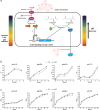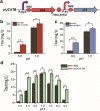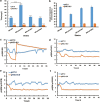Intelligent microbial cell factory with genetic pH shooting (GPS) for cell self-responsive base/acid regulation
- PMID: 33138821
- PMCID: PMC7607686
- DOI: 10.1186/s12934-020-01457-3
Intelligent microbial cell factory with genetic pH shooting (GPS) for cell self-responsive base/acid regulation
Abstract
Background: In industrial fermentation, pH fluctuation resulted from microbial metabolism influences the strain performance and the final production. The common way to control pH is adding acid or alkali after probe detection, which is not a fine-tuned method and often leads to increased costs and complex downstream processing. Here, we constructed an intelligent pH-sensing and controlling genetic circuits called "Genetic pH Shooting (GPS)" to realize microbial self-regulation of pH.
Results: In order to achieve the self-regulation of pH, GPS circuits consisting of pH-sensing promoters and acid-/alkali-producing genes were designed and constructed. Designed pH-sensing promoters in the GPS can respond to high or low pHs and generate acidic or alkaline substances, achieving endogenously self-responsive pH adjustments. Base shooting circuit (BSC) and acid shooting circuit (ASC) were constructed and enabled better cell growth under alkaline or acidic conditions, respectively. Furthermore, the genetic circuits including GPS, BSC and ASC were applied to lycopene production with a higher yield without an artificial pH regulation compared with the control under pH values ranging from 5.0 to 9.0. In scale-up fermentations, the lycopene titer in the engineered strain harboring GPS was increased by 137.3% and ammonia usage decreased by 35.6%.
Conclusions: The pH self-regulation achieved through the GPS circuits is helpful to construct intelligent microbial cell factories and reduce the production costs, which would be much useful in industrial applications.
Keywords: Acid-regulating circuit; Base-regulating circuit; Escherichia coli; Genetic pH regulation; Microbial cell factory.
Conflict of interest statement
The authors declare that they have no competing interests.
Figures








Similar articles
-
Recent advances in engineering of microbial cell factories for intelligent pH regulation and tolerance.Biotechnol J. 2021 Sep;16(9):e2100151. doi: 10.1002/biot.202100151. Epub 2021 Aug 7. Biotechnol J. 2021. PMID: 34164941 Review.
-
Synthetic acid stress-tolerance modules improve growth robustness and lysine productivity of industrial Escherichia coli in fermentation at low pH.Microb Cell Fact. 2022 Apr 22;21(1):68. doi: 10.1186/s12934-022-01795-4. Microb Cell Fact. 2022. PMID: 35459210 Free PMC article.
-
Engineering quorum sensing-based genetic circuits enhances growth and productivity robustness of industrial E. coli at low pH.Microb Cell Fact. 2024 Sep 28;23(1):256. doi: 10.1186/s12934-024-02524-9. Microb Cell Fact. 2024. PMID: 39342182 Free PMC article.
-
Spatiotemporal Gene Expression by a Genetic Circuit for Chemical Production in Escherichia coli.ACS Synth Biol. 2023 Mar 17;12(3):768-779. doi: 10.1021/acssynbio.2c00568. Epub 2023 Feb 23. ACS Synth Biol. 2023. PMID: 36821871
-
Coupling feedback genetic circuits with growth phenotype for dynamic population control and intelligent bioproduction.Metab Eng. 2019 Jul;54:109-116. doi: 10.1016/j.ymben.2019.03.009. Epub 2019 Mar 30. Metab Eng. 2019. PMID: 30940507 Review.
Cited by
-
Temperature-responsive regulation of the polycyclic aromatic hydrocarbon-degrading mesophilic bacterium Novosphingobium pentaromativorans US6-1 with a temperature adaptation system.Appl Environ Microbiol. 2025 Jan 31;91(1):e0148424. doi: 10.1128/aem.01484-24. Epub 2024 Dec 12. Appl Environ Microbiol. 2025. PMID: 39665544 Free PMC article.
-
Separation and purification of plant terpenoids from biotransformation.Eng Life Sci. 2021 Jun 10;21(11):724-738. doi: 10.1002/elsc.202100014. eCollection 2021 Nov. Eng Life Sci. 2021. PMID: 34764825 Free PMC article. Review.
-
Practical genetic control strategies for industrial bioprocesses.J Ind Microbiol Biotechnol. 2022 Apr 14;49(2):kuab088. doi: 10.1093/jimb/kuab088. J Ind Microbiol Biotechnol. 2022. PMID: 35108392 Free PMC article. Review.
-
Using design of experiments to guide genetic optimization of engineered metabolic pathways.J Ind Microbiol Biotechnol. 2024 Jan 9;51:kuae010. doi: 10.1093/jimb/kuae010. J Ind Microbiol Biotechnol. 2024. PMID: 38490746 Free PMC article. Review.
-
Advances in stress-tolerance elements for microbial cell factories.Synth Syst Biotechnol. 2024 Jun 28;9(4):793-808. doi: 10.1016/j.synbio.2024.06.008. eCollection 2024 Dec. Synth Syst Biotechnol. 2024. PMID: 39072145 Free PMC article. Review.
References
-
- Ali S, Ikram-Ul-Haq, Iqbal J. Effect of low pH on continuous citric acid fermentation by Aspergillus niger. Pak. J. Bot. 2005; 37, 981–987.
-
- Kambale SD, George S, Zope RG. Controllers used in pH neutralization process: a review. IRJET. 2015;2:354–361.
-
- Faanes A, Skogestad S. pH-neutralization: integrated process and control design. Comput Chem Eng. 2004;28:1475–1487. doi: 10.1016/j.compchemeng.2003.11.001. - DOI
MeSH terms
Substances
Grants and funding
LinkOut - more resources
Full Text Sources
Miscellaneous

